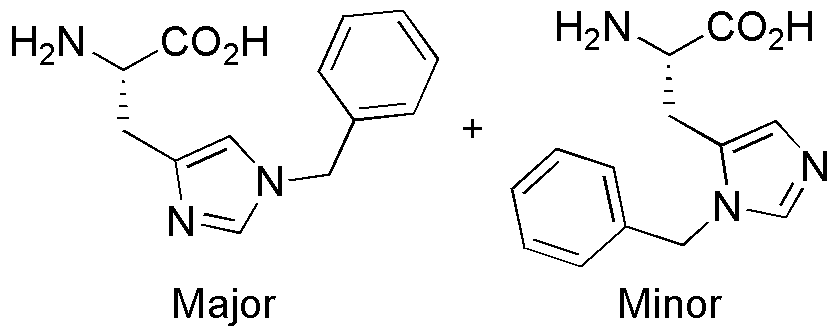Nim-Benzyl-L-histidine is widely utilized in research focused on:
- Biochemical Research: This compound serves as a valuable tool in studying enzyme activity and protein interactions, particularly in the context of histidine-rich proteins.
- Pharmaceutical Development: It is explored for its potential as a drug candidate, especially in targeting specific receptors or pathways in disease models.
- Neuroscience: Researchers use it to investigate neurotransmitter systems, as it may influence synaptic transmission and neuroprotection.
- Peptide Synthesis: Nim-Benzyl-L-histidine is employed in the synthesis of bioactive peptides, enhancing the specificity and efficacy of therapeutic agents.
- Diagnostic Applications: Its unique properties make it a candidate for developing diagnostic tools that can detect specific biomarkers in various diseases.
General Information
Properties
Safety and Regulations
Applications
Nim-Benzyl-L-histidine is widely utilized in research focused on:
- Biochemical Research: This compound serves as a valuable tool in studying enzyme activity and protein interactions, particularly in the context of histidine-rich proteins.
- Pharmaceutical Development: It is explored for its potential as a drug candidate, especially in targeting specific receptors or pathways in disease models.
- Neuroscience: Researchers use it to investigate neurotransmitter systems, as it may influence synaptic transmission and neuroprotection.
- Peptide Synthesis: Nim-Benzyl-L-histidine is employed in the synthesis of bioactive peptides, enhancing the specificity and efficacy of therapeutic agents.
- Diagnostic Applications: Its unique properties make it a candidate for developing diagnostic tools that can detect specific biomarkers in various diseases.
Documents
Safety Data Sheets (SDS)
The SDS provides comprehensive safety information on handling, storage, and disposal of the product.
Product Specification (PS)
The PS provides a comprehensive breakdown of the product’s properties, including chemical composition, physical state, purity, and storage requirements. It also details acceptable quality ranges and the product's intended applications.
Certificates of Analysis (COA)
Search for Certificates of Analysis (COA) by entering the products Lot Number. Lot and Batch Numbers can be found on a product’s label following the words ‘Lot’ or ‘Batch’.
*Catalog Number
*Lot Number
Certificates Of Origin (COO)
This COO confirms the country where the product was manufactured, and also details the materials and components used in it and whether it is derived from natural, synthetic, or other specific sources. This certificate may be required for customs, trade, and regulatory compliance.
*Catalog Number
*Lot Number
Safety Data Sheets (SDS)
The SDS provides comprehensive safety information on handling, storage, and disposal of the product.
DownloadProduct Specification (PS)
The PS provides a comprehensive breakdown of the product’s properties, including chemical composition, physical state, purity, and storage requirements. It also details acceptable quality ranges and the product's intended applications.
DownloadCertificates of Analysis (COA)
Search for Certificates of Analysis (COA) by entering the products Lot Number. Lot and Batch Numbers can be found on a product’s label following the words ‘Lot’ or ‘Batch’.
*Catalog Number
*Lot Number
Certificates Of Origin (COO)
This COO confirms the country where the product was manufactured, and also details the materials and components used in it and whether it is derived from natural, synthetic, or other specific sources. This certificate may be required for customs, trade, and regulatory compliance.

